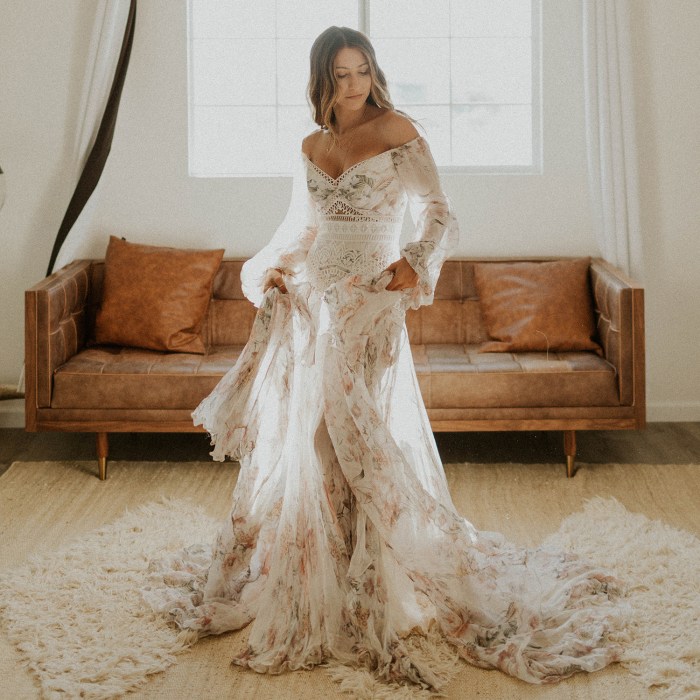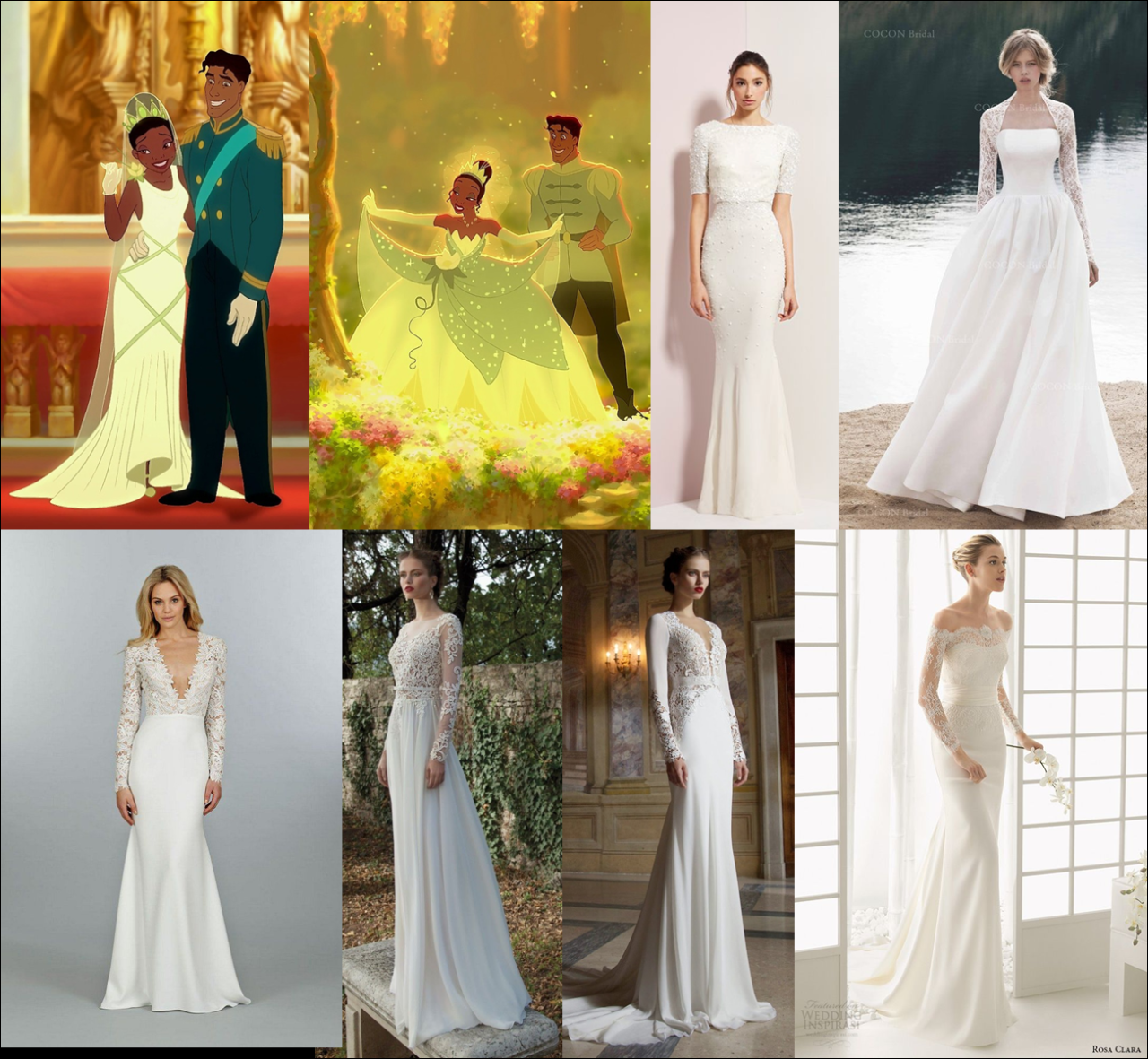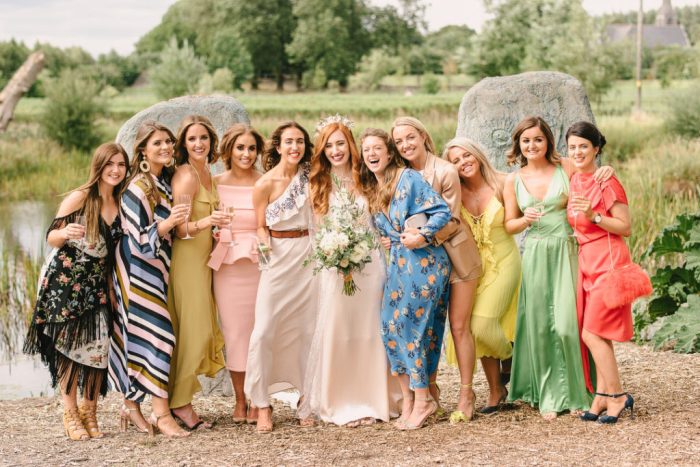Asymmetrical Necklines in Wedding Dresses: A Modern Bridal Trend: Asymmetrical Neckline Wedding Dress
Asymmetrical neckline wedding dress – Asymmetrical necklines have emerged as a captivating trend in bridal fashion, offering a unique and stylish alternative to traditional designs. Their versatility allows for a range of interpretations, catering to diverse body types, wedding themes, and personal aesthetics. This exploration delves into the intricacies of asymmetrical necklines, encompassing their design elements, styling considerations, historical context, and illustrative examples.
Defining Asymmetrical Necklines
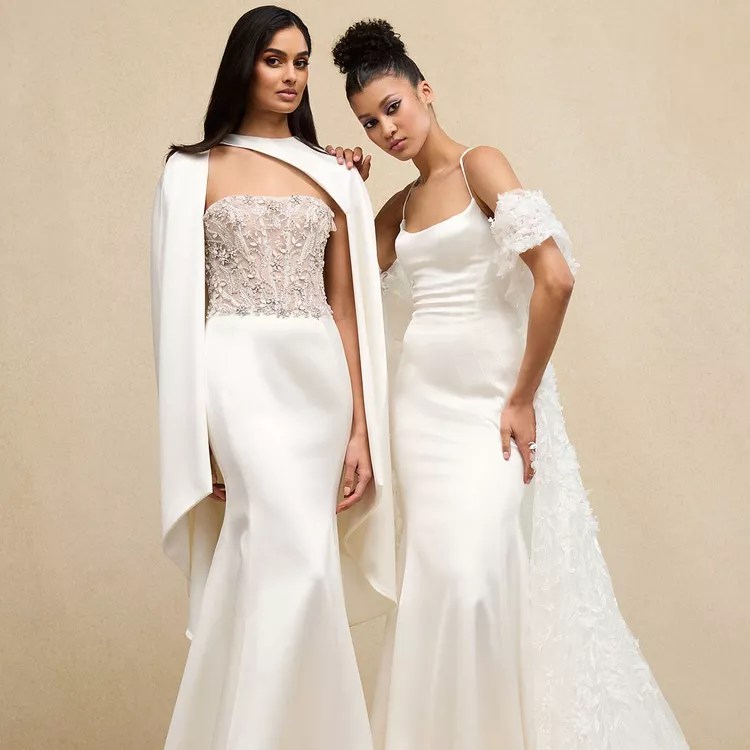
Source: onefabday.com
Asymmetrical necklines, by definition, deviate from symmetrical designs, creating a visually striking imbalance. This imbalance can manifest in various ways, resulting in a multitude of captivating styles. The visual impact of these necklines is significantly influenced by the specific design and the bride’s physique.
- One-Shoulder Necklines: These dramatic necklines showcase one shoulder, often incorporating a flowing drape or strap on the opposite side. They flatter brides with broad shoulders or a balanced figure.
- Halter Necklines with Asymmetrical Drape: A halter neckline, typically featuring a strap around the neck and leaving the back exposed, can be made asymmetrical through an uneven drape or a single, strategically placed strap. This style is well-suited for various body types, offering a balance of coverage and exposure.
- Cowl Neck with Uneven Hemline: A cowl neckline, characterized by its soft, draped fabric around the neck and shoulders, can be rendered asymmetrical by incorporating an uneven hemline, either at the front or the back. This adds an element of fluidity and movement.
For example, a one-shoulder neckline might accentuate the collarbone and shoulders of a bride with a slender frame, while a halter neckline with an asymmetrical drape could balance a fuller bust. A cowl neck with an uneven hemline can add a sense of movement and drama to any figure.
Asymmetrical neckline wedding dresses offer a modern and stylish alternative to traditional gowns. However, the beauty of a unique neckline shouldn’t be compromised by chilly weather; consider checking out helpful resources like this guide on what to wear over wedding dress if cold to ensure you stay warm without obscuring your dress’s design. With the right layering, your asymmetrical neckline will remain a stunning focal point, even on a cool day.
Asymmetrical necklines can be seamlessly integrated into various wedding themes. A one-shoulder gown with clean lines suits a modern minimalist theme, while a halter neckline with intricate beading complements a classic or glamorous style. A flowing, asymmetrical neckline crafted from bohemian fabrics aligns perfectly with a rustic or bohemian wedding theme.
Design Elements & Fabrics
The choice of fabric significantly impacts the drape and overall aesthetic of an asymmetrical neckline wedding dress. Certain fabrics lend themselves better to creating the desired asymmetry and fluidity, while others may appear stiff or unyielding.
Lightweight fabrics such as chiffon, silk charmeuse, and crepe are ideal for creating soft, flowing asymmetrical drapes. Heavier fabrics like brocade or lace can also be used, but they require careful construction to avoid overwhelming the design. Conversely, stiff fabrics like taffeta or heavy satin might not drape as well and could hinder the creation of a graceful asymmetrical neckline.
The interplay between the asymmetrical neckline and other design elements is crucial. Sleeves, back details, and train length all contribute to the overall balance and harmony of the dress. For instance, a one-shoulder neckline might pair well with a long sleeve on the opposite side or an elaborate back detail. A long train can enhance the dramatic effect of an asymmetrical neckline, while a shorter train can create a more modern and minimalist look.
| Dress Style | Fabric | Neckline Detail | Embellishments |
|---|---|---|---|
| A-line | Silk Charmeuse | One-shoulder with cascading ruffle | Delicate beading along the shoulder strap |
| Sheath | Lace | Halter with asymmetrical drape and open back | Crystal embellishments along the asymmetrical drape |
| Mermaid | Crepe | Cowl neck with uneven hemline at the front | Simple, elegant embroidery at the waist |
Styling & Accessories
Accessories play a vital role in complementing the unique features of an asymmetrical neckline. The choice of jewelry and other accessories should enhance the overall aesthetic without overpowering the dress’s design.
- One-Shoulder Necklines: A single, statement earring on the exposed shoulder, a delicate necklace, or a bracelet on the opposite wrist can create a balanced and elegant look.
- Halter Necklines: Dainty necklaces or layered necklaces can be worn with these necklines, but avoid anything too bulky or that might compete with the neckline’s design. Statement earrings are also a great option.
- Cowl Necklines: Subtle earrings or a simple pendant necklace would be appropriate. Focus on the overall texture and fluidity of the look.
Hair and makeup should complement the overall aesthetic of the dress. A sleek updo or a loose, romantic hairstyle can work well with an asymmetrical neckline. Makeup should be natural and enhance the bride’s features without being too distracting. The choice of neckline should influence the overall bridal look, ensuring coordination with the wedding venue and theme. A modern asymmetrical neckline might suit a contemporary city venue, while a more traditional style might be more appropriate for a rustic or classic setting.
Historical & Cultural Influences, Asymmetrical neckline wedding dress
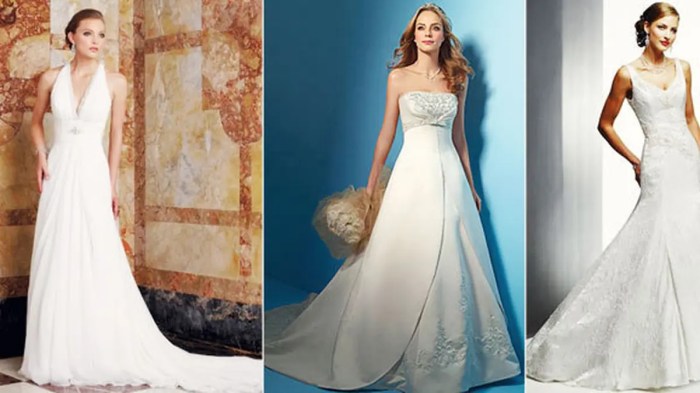
Source: akamaized.net
Asymmetrical necklines have a rich history across various cultures and historical periods. Their evolution in bridal fashion reflects changing societal norms and aesthetic preferences.
- Ancient Greek and Roman clothing often featured asymmetrical elements, including draped garments and uneven hemlines, influencing later designs.
- The Art Deco era of the 1920s and 1930s saw a rise in asymmetrical designs, characterized by geometric shapes and a focus on modern aesthetics. This influence is still visible in contemporary bridal fashion.
- The 1970s and 1980s witnessed the emergence of bohemian styles, which incorporated flowing fabrics and asymmetrical necklines, creating a sense of effortless elegance.
- Modern bridal fashion continues to incorporate asymmetrical elements, often blending traditional and contemporary influences.
While asymmetrical necklines are prevalent in Western bridal fashion, their presence varies across different cultures. Certain cultural traditions may favor symmetrical designs, while others embrace asymmetry as a symbol of individuality or artistic expression.
Illustrative Examples
Consider three distinct asymmetrical neckline wedding dresses:
Dress 1: A flowing A-line gown in silk chiffon, featuring a one-shoulder neckline with a cascading ruffle. The overall effect is romantic and ethereal. The construction involves creating a bias-cut ruffle and attaching it to one shoulder strap, allowing it to drape elegantly.
Dress 2: A sheath dress in delicate lace, showcasing a halter neckline with an asymmetrical drape and an open back. This design offers a blend of elegance and modernity. The construction involves carefully layering the lace to create the uneven drape and ensuring a secure fit around the neck and back.
Dress 3: A mermaid gown in crepe fabric, with a cowl neckline and an uneven hemline at the front. The overall effect is sleek and sophisticated. The construction involves draping the crepe fabric to create the cowl neckline and carefully cutting the hemline to achieve the desired asymmetry.
To visually represent an asymmetrical neckline in a simple fashion sketch, start with a basic figure Artikel. Then, sketch the neckline, paying close attention to the uneven lines and curves. Add details such as fabric folds and drapes to enhance the sketch’s realism.
FAQ Explained
How do I choose the right asymmetrical neckline for my body type?
Consider your figure. One-shoulder styles flatter hourglass and pear shapes, while halter necklines suit athletic builds. Consult a stylist for personalized advice.
Can I wear an asymmetrical neckline dress if I have a smaller bust?
Absolutely! Choose styles with added detailing or embellishments near the neckline to create visual balance.
What kind of undergarments should I wear with an asymmetrical neckline?
Select seamless, strapless bras or adhesive lift tapes to avoid visible lines and maintain a smooth silhouette.
Are asymmetrical necklines suitable for all wedding venues?
Yes, but consider the formality of the venue. A more dramatic asymmetrical neckline might be better suited for a formal setting, while a simpler style could work well for a casual or rustic wedding.






